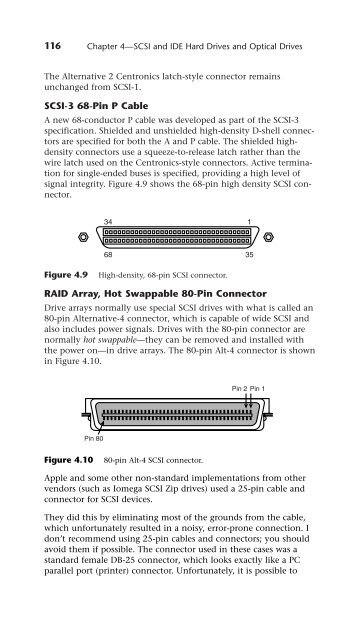UPGRADING REPAIRING PCs
UPGRADING REPAIRING PCs
UPGRADING REPAIRING PCs
Create successful ePaper yourself
Turn your PDF publications into a flip-book with our unique Google optimized e-Paper software.
116<br />
Chapter 4—SCSI and IDE Hard Drives and Optical Drives<br />
The Alternative 2 Centronics latch-style connector remains<br />
unchanged from SCSI-1.<br />
SCSI-3 68-Pin P Cable<br />
A new 68-conductor P cable was developed as part of the SCSI-3<br />
specification. Shielded and unshielded high-density D-shell connectors<br />
are specified for both the A and P cable. The shielded highdensity<br />
connectors use a squeeze-to-release latch rather than the<br />
wire latch used on the Centronics-style connectors. Active termination<br />
for single-ended buses is specified, providing a high level of<br />
signal integrity. Figure 4.9 shows the 68-pin high density SCSI connector.<br />
34 1<br />
68 35<br />
Figure 4.9 High-density, 68-pin SCSI connector.<br />
RAID Array, Hot Swappable 80-Pin Connector<br />
Drive arrays normally use special SCSI drives with what is called an<br />
80-pin Alternative-4 connector, which is capable of wide SCSI and<br />
also includes power signals. Drives with the 80-pin connector are<br />
normally hot swappable—they can be removed and installed with<br />
the power on—in drive arrays. The 80-pin Alt-4 connector is shown<br />
in Figure 4.10.<br />
Pin 80<br />
Figure 4.10 80-pin Alt-4 SCSI connector.<br />
Pin 2 Pin 1<br />
Apple and some other non-standard implementations from other<br />
vendors (such as Iomega SCSI Zip drives) used a 25-pin cable and<br />
connector for SCSI devices.<br />
They did this by eliminating most of the grounds from the cable,<br />
which unfortunately resulted in a noisy, error-prone connection. I<br />
don’t recommend using 25-pin cables and connectors; you should<br />
avoid them if possible. The connector used in these cases was a<br />
standard female DB-25 connector, which looks exactly like a PC<br />
parallel port (printer) connector. Unfortunately, it is possible to
















